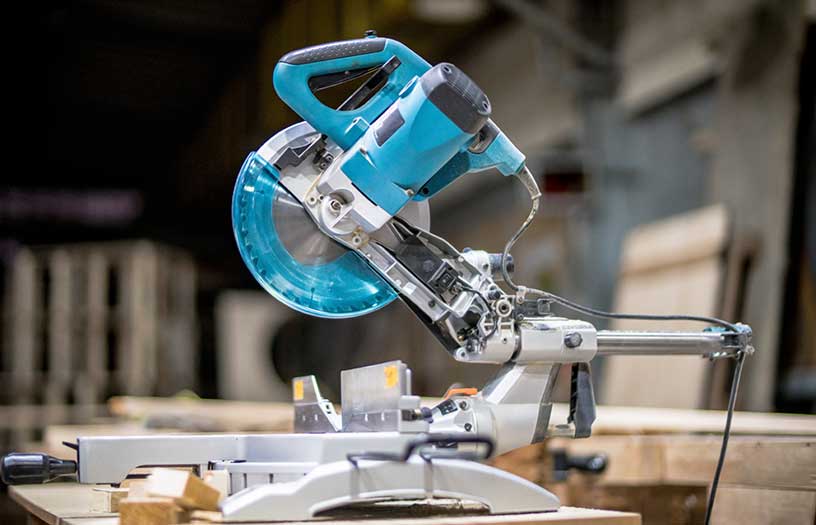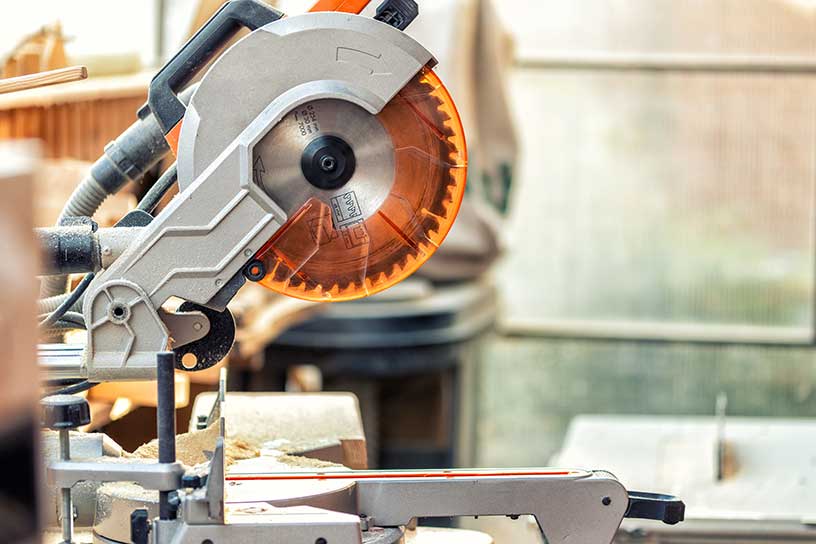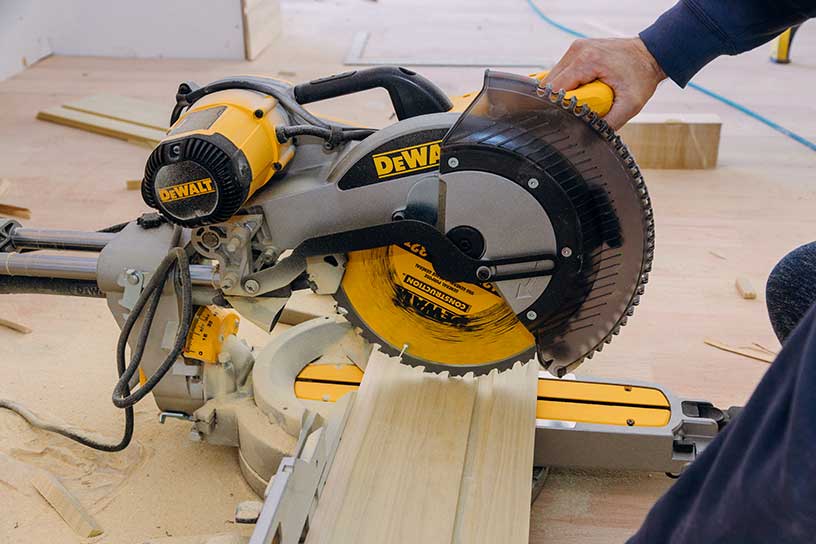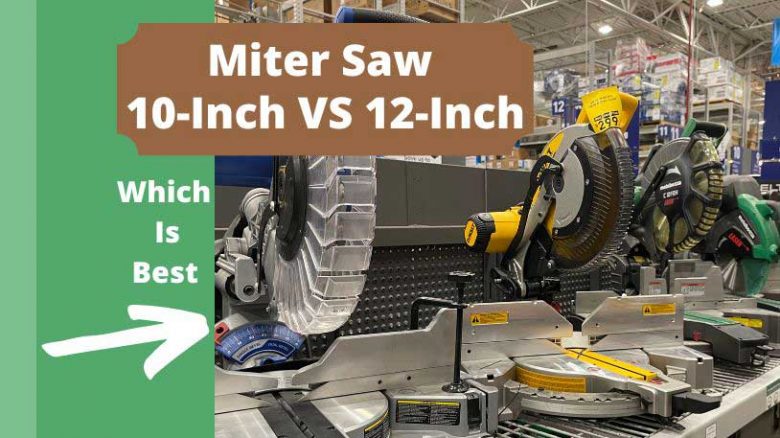Miter saws are excellent tools you can invest in to save time and labor involved in cutting wood. However, settling on the specs you want for your Miter saw can be challenging since its size and features will impact how you can use it.
If you want a saw that will make precise cuts for a low price, go with the Miter saw 10″. However, if you need to cut through thick materials or hardwoods, you’re better off with the Miter saw 12″. While the Miter 12″ can cut through more materials, it comes at a much higher cost.
Continue reading this article for an analysis of both varieties of Miter saws. I’ll examine the merits and disadvantages of owning and using these saws and tell you which tools are best for what job. I’ll also outline the similarities so you can make a well-informed decision on which of the two machines is the best.
Basic Similarities Between Miter Saws 10 Inch and 12 Inch
While there are distinct differences between these Miter saws, there are certainly some basic similarities. When you weigh out which saw is best for you, it’s worthwhile to address what the saws have in common.
So, let’s go through some basic similarities between the Miter 10″ and Miter 12″ saws.
Same Motor
Despite the differences in size between the 10″ saw and the 12″ saw, they both use the same motor. The motor that powers the saw is the same size and has the same strength and output in both devices. While this is a similarity, it’s also one of the factors that set these saws apart – but more on that later.
The motor in a Miter saw has a very high RPM, although the number varies between the two saw sizes. The engine’s high rotation speed on both saws allows for precise cuts and excellent accuracy, which sets Miter saws above other motor-powered saws.
Wood Saws
The Miter 10″ and 12″ saws are for cutting through wood. However, both Miter saws are suitable for cutting through several different materials, including metals, masonry materials, and tiles.
However, it’s worth noting that the Miter saw 12″ is better for cutting through more rigid and thicker materials due to the larger blade size and cutting edge.
Electric Powered
Another similarity between these two saws is that they need electricity to run. In other words, you need to plug them in. As a result, you’ll need a power supply like a wall socket or generator when using these devices. They use a very similar amount of power as the motors inside are identical.
Portable
While the smaller-sized saw is easier to transport, both electric saws are portable. As a result, you can quickly bring your portable motor wherever you need to use it on your property. You can also get these tools to a work site as they are not too heavy and run on electricity.
While the two Miter saws are portable, using them on a flat surface like the floor or a tabletop is best. It’s not advisable to cut through materials using these saws like a handheld saw as they’re mighty, and making a mistake could cause a nasty injury.
Quality
One thing that’s pretty much guaranteed when buying either Miter saw is that you’re buying quality. While the saws are not in the same price bracket, they are both built to last using high-quality materials and offer consistent results if you maintain them correctly.
Miter saws are precise tools. Even though some saws are more accurate, every type of Miter saw is a precision cutting tool. As a result, you can be confident that either of these saws will make precise cuts.
With so many shared qualities and components, it’s hard to see at this point where the two Miter saws are different. Luckily, I’ve compiled the information below to see the merits and drawbacks of owning the two Miter saws.
Miter Saw 10 Inch Pros and Cons
See below for a table highlighting the pros and cons of the Miter Saw 10″. Below the table, I’ll discuss the points mentioned in detail.

PROS
- Accurate Cuts
- Affordable
- Low Maintenance Costs
- Less Blade Wobble
- Easy to Transport
CONS
- Can’t Make Thick Cuts
- Struggles With Hardwoods
- Prone to Wear
The Miter Saw 10″ is a strong, compact electric power saw with a 10″ (25 cm) blade. This saw comes with a variety of blades. However, they all work the same way.
A circular blade fits onto the saw, and it cuts with a downward circular motion. The Miter 10″ saw can cut through an assortment of materials, but the bigger size saw can cut through more.
The Miter 10″ saw has a very high rotation per minute (RPM) as it contains a powerful motor and a small blade. This high-speed cutting means that the blade will not wobble while spinning. This wobble reduction will result in more precise, reliable cuts using this saw.
The Miter 10″ saw also comes with an affordable price tag, especially when compared to the Miter 12″ saw. This price reduction makes this device ideal for DIY-ers, amateur woodworkers, and people who want to make occasional home improvements.
The Miter 10″ saw is lightweight, small, and compact. As a result, you can easily transport this device to wherever you need to go. This is a significant advantage that Miter 10″ saws have over Miter 12″ saws.
Maintaining the Miter 10″ is also cheaper than keeping up with the Miter 12″. The cost of replacing blades is lower, and even hiring someone to sharpen the blade on this device is more affordable with the smaller-sized Miter saw.
One of the most significant drawbacks to the Miter 10″ electric saw is the fact that it is unable to make thick cuts. If the piece of wood you’re cutting is more than 6″ (15 cm) wide, you’re going to need to make two cuts or use another saw. As a result, this saw is best for cutting thin pieces of wood like trimming and skirting boards.
Another disadvantage to the smaller 10″ (25 cm) blade on this saw is that it struggles to cut some materials, such as hardwoods, tile, and concrete. This saw can cut through the majority of materials that the 12″ can, although harder metals, some ceramics, and some types of hardwood are too harsh for this small blade.
Lastly, the Miter 10″ saw is much more vulnerable to wear and tear than the larger-sized saws. As a result, if you choose this Miter saw over the Miter 12″, you will likely need to invest in a replacement much sooner.
However, maintaining the Miter 10″ is far cheaper than the larger model. The blades are more inexpensive and easy to source and replace. As a result, the low price tag and maintenance costs make the Miter Saw 10″ good value for money and the ideal choice for a casual wood-cutter.
Miter Saw 12 Inch Pros and Cons
See below for a table highlighting the pros and cons of owning and using a Miter 12″ electric saw.

PROS
- Saves Time and Labor
- Durable
- Versatile
- Thick Cuts
- Can Cut Hardwoods
CONS
- High Price Tag
- Expensive Maintenance
- Low Accuracy
- Low Blade Speed
- A Bit Bulky
The Miter 12″ saw is a robust and powerful device that can easily slice through thick materials, including wood and some metals and masonry materials. The 12″ Miter saw features a blade with a diameter of one foot (30.48 cm). This large blade size makes this device a powerful cutting tool ideal for construction projects.
The Miter 12″ saw can quickly cut through thick and strong materials, especially compared to the smaller model. As a result, if you need to make multiple cuts at once or are cutting through thicker materials, you can save vast amounts of time and effort using the Miter 12″ over the Miter 10″.
You’ll likely need to make multiple cuts when using a Miter 10″ saw to cut through thick materials. Trying to cut materials too thick for the saw or dividing those materials into smaller sections will increase your risk of making a poor cut while also wasting your time – this is not a problem you will face with the Miter 12.
Another significant advantage of purchasing the Miter 12″ saw is its added versatility. You can swap out the 12″ (30 cm) blade for a 10″ blade, and you will effectively have a Miter 10″. Since both saws have the same motor inside, you can use the Miter 12″ to make precision cuts, just as you would with the Miter 10″.
Once you’ve purchased a Miter 12″ saw, you likely won’t need to invest in another one for a long time because the Miter 12″ is a well-built and remarkably durable machine. However, it requires general maintenance, like replacing damaged blades and sharpening blunted chatting edges.
Maintaining the Miter 12″ saw is more costly than maintaining the smaller model. The Miter 12″ has a larger saw, so paying for a replacement can be expensive. On top of this, it’s not so cheap to have the Miter 12″ blade sharpened, either.
The Miter 12″ saw is not just costly to maintain – it also has a very high initial price. The hefty price tag of this device makes it unaffordable for many people, and despite the extra performance benefits, it’s hard to justify the investment for casual hobbyists.
When using the Miter 12″ saw with the original 12″ (30 cm) blade, the saw will rotate slower than the Miter 10″. That is because the Miter 12-inch has no added speed in the motor despite the larger and heavier blade.
Since the Miter 12″ is slower than the smaller model, the blade is prone to bending and bowing slightly when in use. This warping can result in poor-quality cuts. As a result, if you need a precision cutting tool, the Miter 12″ best be avoided unless you’re using a smaller-sized blade.
The Miter 12″ saw is portable, although it’s nowhere near as easy to lift as the smaller option. This tool is heavy, so you can’t conveniently carry it wherever you go. Instead, it’s best to set up the Miter 12″ on a surface like a workbench and bring the materials to it.
Is a 10-inch Miter Saw More Accurate than a 12-inch Miter Saw?
One primary concern that people have when choosing a saw is precision. If a saw blade is not precise, it can cause your cut to go wrong and waste materials. So, that begs the question, which of these two Miter saws are more accurate, the 10″ or 12″?
A 10-inch Miter saw is more accurate than a 12-inch Miter saw. Both saws have the same motor. As a result, the 10-inch blade can spin faster due to its smaller size. Faster cuts are more accurate and precise than slower cuts, as the blade will wobble less and stay on track.
The Miter 10″ is a highly accurate cutting tool. The design of the saw, alongside the speed of the blades, allows you to cut with high amounts of precision. This ability to make consistent cuts makes the Miter 10″ ideal for cutting fittings and skirting boards and creating joints for your woodwork projects with relative ease.
However, while the Miter 10″ saw is more accurate than the Miter 12″, you can still make changes to the Miter 12″, like swapping out the big blade for a smaller one that allows you to make more accurate cuts.
Is a 12-inch Miter Saw More Cost-Effective than the Miter 10-inch Saw?
A 12-inch Miter saw is more expensive than a Miter 10-inch saw. However, the Miter 12″ lasts longer than the smaller alternative, and the blades are more durable, reducing the costs of replacements. This longevity (and lack thereof) begs the question, which saw is cheaper in the long run, the Miter 12″ or Miter 10″?
A 10-inch Miter saw is more accurate than a 12-inch. A 12-inch Miter saw is not more cost-effective than a Miter 10-inch saw. Although the Miter 12″ lasts longer and requires less care than the Miter 10″, the high initial and maintenance costs make this electric saw much more expensive in the long run.
The Miter 10″ is the cheaper of the two. As a result, if you’re looking for a saw that offers a good bang for your buck, look no further. However, if you need to cut more rigid materials or if you want to make thick cuts, choose the Miter 12″.
The Miter 12″ saw could be more cost-effective if you regularly cut rigid materials like metals or thick hardwood planks. This large saw’s added weight and power means that the blades can hold up against high amounts of wear and tear. Smaller-sized saws would often break when cutting these materials, which in turn would raise the maintenance costs.
Related: All You Need To Know About Miter Saws
Which Miter Saw Is Best?

Now you know how each of these saws works and the pros and cons of the Miter 10″ and 12″, it’s time to address which is best.
The Miter 12″ saw is the best all-around due to its versatility and ability to make thick cuts through hard materials. However, the high price tag makes this power saw an unnecessary investment unless you need to make thick cuts. For most jobs, the cheaper Miter 10″ is sufficient.
The main reason the Miter 12″ is better than the 10″ as a cutting tool is its versatility. You can swap out the 12″ blade for a 10″ blade on the larger saw.
Therefore, if you come across a project that’s better suited to a Miter 10″ but only has a Miter 12″, you can swap the blades and get to work. This option is not possible on the Miter 10″, as the 12″ edges are too big to fit into the device.
However, as I mentioned above, the Miter 12″ is much more expensive than the Miter 10″, and most people don’t need the extra cutting power offered by the Miter 12″. Therefore, if you don’t use your saws weekly, only cut smaller pieces of softer woods, or need to keep on a strict budget, the Miter 10″ is likely the best choice.
However, if you need a tool that can assist you in construction projects or if you often work with metal, tile, and hardwoods, you might consider going with the Miter 12″.
Final Thoughts
The 10″ and 12″ Miter Saw are excellent precision saws that use similar technologies. They both have the same motor, and the Miter saw 12″ can even become 10″ if you swap out the blades. However, these two machines differ in many ways, especially regarding cost and accuracy.
The Miter Saw 10″ offers superior precision and is considerably cheaper to purchase and maintain. However, the Miter 12″ can last longer and is better for cutting through thicker and harder materials than the Miter Saw 10″.

